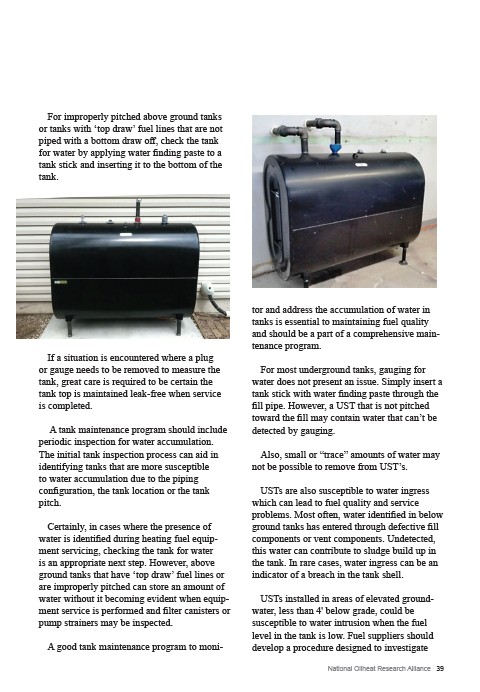
National Oilheat Research Alliance 39
For improperly pitched above ground tanks
or tanks with ‘top draw’ fuel lines that are not
piped with a bottom draw off, check the tank
for water by applying water finding paste to a
tank stick and inserting it to the bottom of the
tank.
If a situation is encountered where a plug
or gauge needs to be removed to measure the
tank, great care is required to be certain the
tank top is maintained leak-free when service
is completed.
A tank maintenance program should include
periodic inspection for water accumulation.
The initial tank inspection process can aid in
identifying tanks that are more susceptible
to water accumulation due to the piping
configuration, the tank location or the tank
pitch.
Certainly, in cases where the presence of
water is identified during heating fuel equipment
servicing, checking the tank for water
is an appropriate next step. However, above
ground tanks that have ‘top draw’ fuel lines or
are improperly pitched can store an amount of
water without it becoming evident when equipment
service is performed and filter canisters or
pump strainers may be inspected.
A good tank maintenance program to monitor
and address the accumulation of water in
tanks is essential to maintaining fuel quality
and should be a part of a comprehensive maintenance
program.
For most underground tanks, gauging for
water does not present an issue. Simply insert a
tank stick with water finding paste through the
fill pipe. However, a UST that is not pitched
toward the fill may contain water that can’t be
detected by gauging.
Also, small or “trace” amounts of water may
not be possible to remove from UST’s.
USTs are also susceptible to water ingress
which can lead to fuel quality and service
problems. Most often, water identified in below
ground tanks has entered through defective fill
components or vent components. Undetected,
this water can contribute to sludge build up in
the tank. In rare cases, water ingress can be an
indicator of a breach in the tank shell.
USTs installed in areas of elevated groundwater,
less than 4' below grade, could be
susceptible to water intrusion when the fuel
level in the tank is low. Fuel suppliers should
develop a procedure designed to investigate